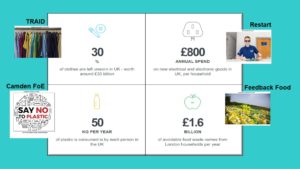Dealing with Haringey Waste

Key Messages
- Reduce – use less material, keep products for longer
- Reuse – check, clean, repair, refurbish
- Recycle – turn into a new substance or product
- Recover – anaerobic digestion recovers nutrients and fuel
- Failure of a circular economy – disposal to landfill or incineration
Getting the millions of people who produce the waste and the authorities who process the waste to achieve a circular economy is hard. How to end up with next to nothing to dispose of from North London?
Waste is not included in Haringey’s Climate Change Action Plan (HCCAP) of March 2021, other than for waste it generates itself (p8).
Haringey Council does have responsibility for dealing with Haringey waste (other than Commercial and Industrial (C&I) waste that can be privately handled) and it contracts with the NLWA for Reduction, Reuse and Recycling and for disposal. It contracts with Veolia for collection.
The cabinet member in Haringey responsible for the collection stages of waste including street scene improvement and the public realm and waste management and enforcement is Cllr Seema Chandwani at seema.chandwani@haringey.gov.uk
The cabinet member for the disposal stage of waste and sits on the board of the North London Waste Authority (NLWA) and for Air Quality is Cllr Mike Hakata at mike.hakata@haringey.gov.uk
The circular economy in London

The London Environment Strategy DRAFT FOR PUBLIC CONSULTATION AUGUST 2017 (p12) says that “Waste has a big impact on the environment both locally and globally. Only half of the 7m tonnes of waste London’s homes and businesses produce each year is currently recycled, and landfill capacity is set to run out by 2026.
Plastic packaging not only litters London streets, but often finds its way into waterways and oceans, releasing toxic chemicals before breaking down – a process that can take centuries.
London needs to reduce, reuse and recycle more, to see waste as the valuable resource that it is and to reduce London’s increasing waste bill as the city grows.”
Zero Waste Cities has an depth exploration of the issues and opportunities for Municipalities to handle their ‘waste’ including a toolkit to arrive at an optimum regime and a calculator for the savings to be made compared with many incinerator focussed systems.
North London discarded 1,796,000 tonnes of household and commercial/industrial waste in 2021, including 190,000 tonnes from Haringey, according to the London Plan (p386).
WHAT TO DO WITH IT ALL?
The Waste Collection page has more information about ways to get more recycled.
The Disposing of Waste page has more information about the horrors of landfill, the horrors of incineration and less bad ways to deal with North London waste.
